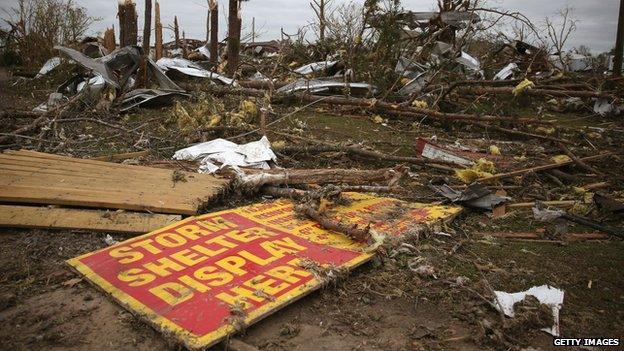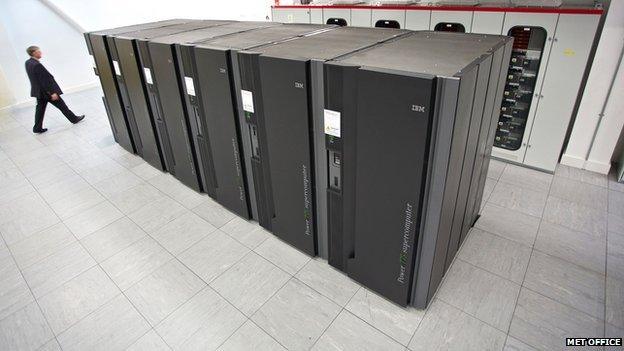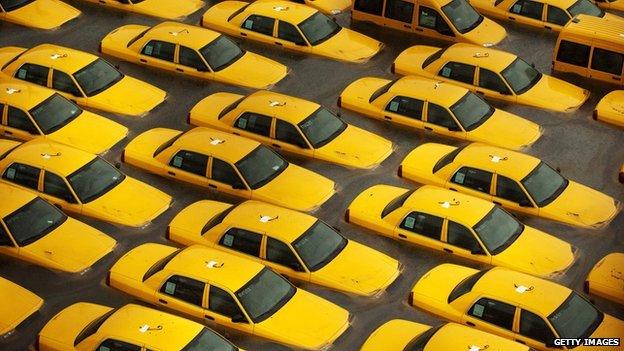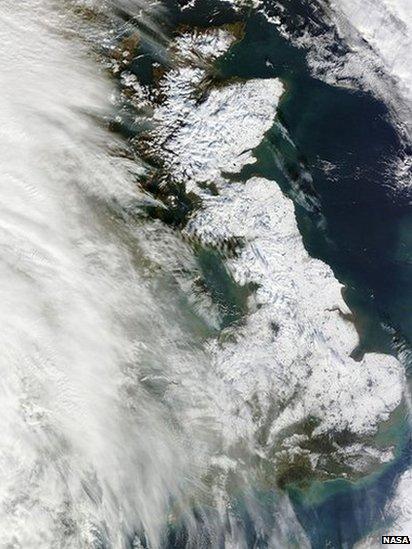Weather report: Forecasts improving as climate gets wilder
- Published

Meteorologists are getting better at forecasting "extreme weather events"
In October 1987, UK weather forecaster Michael Fish famously dismissed fears that a hurricane was on the way, only to be proved disastrously wrong just hours later.
While technically not a hurricane, the storm that battered southern England was the worst for nearly 300 years, causing 18 deaths and £2bn worth of damage.
But such forecasting catastrophes are now a thing of the past, meteorologists would have us believe.
The UK's Met Office says its four-day forecast is now as accurate as its one-day forecast was 30 years ago.
And Louis Uccellini, director of the National Weather Service, part of the US government's National Oceanic and Atmospheric Administration, says: "We can now predict extreme weather events five to seven days in advance.
"Twenty years ago we would only have been able to look one day ahead."
Michael Fish's notorious "hurricane" forecast from 1987
These improvements have only come about after investing billions in better satellites, weather stations and supercomputers.
But with more than a third of the world's total economic output affected by weather, according to US data specialists Weather Analytics, such investment was essential.
Why weather matters
Weather affects almost everything we do, from the clothes we wear, to how much beer we drink on hot days. It even seems to influence how much crime we commit and how responsive we are to adverts.
"We can see the direct effect weather has on sales," says Jim Manzi, chairman of Applied Predictive Technologies, a big data analytics company.
"There's an optimal temperature range for a retailer. If it's too low people don't go to the store; if it's too high they go and do something else. And this changes by geography."
"Transportation, agriculture, hazard mitigation - pretty much everything the economy depends on is affected by the weather," says Chris Davis, a senior scientist at the US National Corporation for Atmospheric Research.

Weather-related insurance claims now top $200bn (£120bn) a year
Where to site wind and solar farms, where to pump your gas supplies, the best time to promote a soft drink, where and when to transport goods by sea and air - all these decisions are dependent on reliable, accurate weather forecasts as well as an understanding of historic weather patterns, adds Emmett Soldati from Weather Analytics.
And with weather-related global insurance payouts now topping $200bn (£120bn) a year, according to the World Bank, forewarning is of increasing commercial importance.
Eyes in the sky
The improvement in short-range forecasting has been achieved thanks to a huge increase in the number of global observations, better numerical models, and the rise of supercomputers, weather scientists say.
Scores of geo-stationary and polar orbiting satellites bristling with a variety of sensors - along with hundreds of land, sea and air weather stations - contribute about two billion observations a day to the National Weather Service and other weather authorities around the world.
"The instruments are much better quality now and we have many more of them," says Simon Keogh, head of the Met Office's data products and systems group.

Mount Spurr in Alaska (marked by the triangle) throws up a volcanic ash cloud - but where is it? Satellite infrared imagery reveals the answer
For example, satellites using infrared can spot and track volcanic ash clouds - the bane of international airlines - when such clouds are often invisible to the naked eye.
"We're also getting the weather data from them much more quickly and with much better co-operation from other data collecting countries around the world," says Mr Keogh.
This increased accuracy is also helped by the millions of additional weather observations made by enthusiastic amateurs, the Met Office says.
Since June 2011, its Weather Observations Website, external has received about 150 million entries from members of the public, with contributions coming from over 180 countries across the globe.
Data crunching
All this data has to be collated, sorted and formatted for crunching by increasingly powerful "petaflop" supercomputers, capable of carrying out one thousand million million calculations a second (that's 10 to the power of 15).
The data is fed into complex mathematical models that are constantly being tweaked and refined. The more accurate the snapshot of what the weather is doing now, the less guesswork there needs to be in the predictive models. This helps to make the forecasts more accurate.

Weather models are so complex they need supercomputers to crunch all the data
"We have about two-and-a-half hours to process all that data and come up with 20 different scenarios for a forecast, using statistical processing to select the most likely," says Mr Uccellini.
Once the data is ready for crunching, "a global seven-day forecast takes us about 40 minutes to produce," says Paul Selwood, the Met Office's manager of high-performance computing optimisation.
Neighbourhood watch
Weather forecasts are also becoming more precise over smaller areas, as modern instruments record greater and greater levels of detail.
For example, meteorologists used to divide the globe up into a grid of boxes about 25x25km in size.
"Now they're down to 17km," says Mr Keogh. "And there are high-resolution models that can focus on blocks of 1km."

In October 2012, Hurricane Sandy caused massive flooding along the US eastern seaboard...

....but the damage and loss of life would have been far greater without its early warnings, says the US National Weather Service
Weather radars can now distinguish between rain, snow, sleet and hail and create 3D maps of storms with a resolution of 1km.
And warnings of flash floods and tornadoes can now be targeted at specific neighbourhoods, says Mr Uccellini, with at-risk residents receiving alerts on their GPS-enabled smartphones.
"People's lives and their property are at risk if they don't get these forecasts in time," he says.
Imperfect science

Satellite imagery shows a snowbound Britain in January 2013
Extending the accuracy of forecasts by several days may not seem like a dramatic improvement to some sceptics, but weather is wild, immensely complex and constantly in flux.
"We all know that it can be chucking it down with rain in one town and dry and sunny in another just a few miles away," says Mr Selwood.
"That sort of variability is going on all over the world and throughout every layer of the atmosphere."
So a 100% accurate forecast is impossible, and the further ahead we look, the greater the margin for error.
Then again, "if you say the weather tomorrow will the same as today, 70% of the time you will be right," says Simon Keogh. "That's the skill level we have to beat."
And Mr Uccellini admits: "I can never give you a perfect forecast and I never will be able to, but I can give you one with increasing reliability and accuracy."
Forewarned is forearmed, they say. And better forecasts save money - and lives.